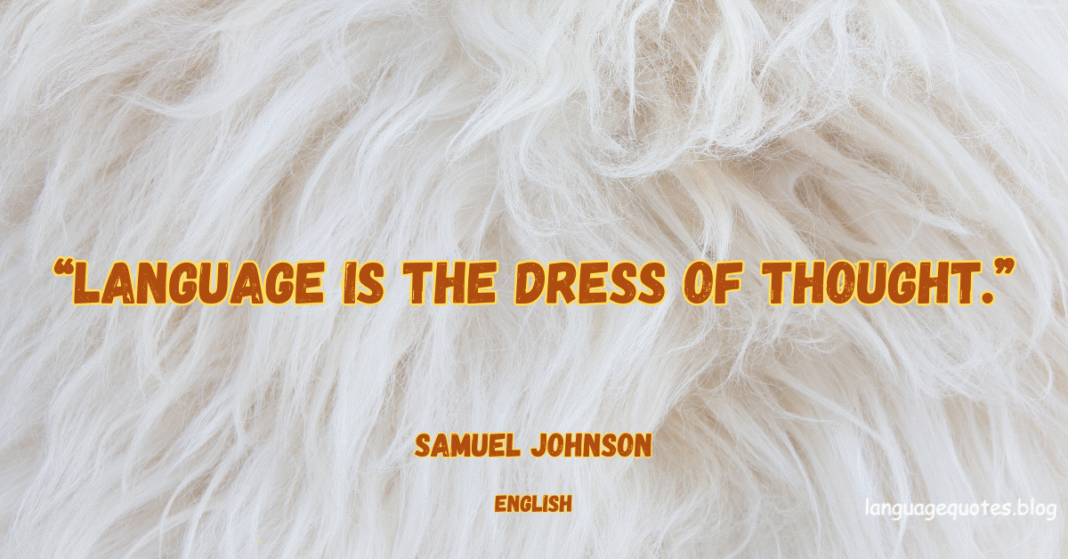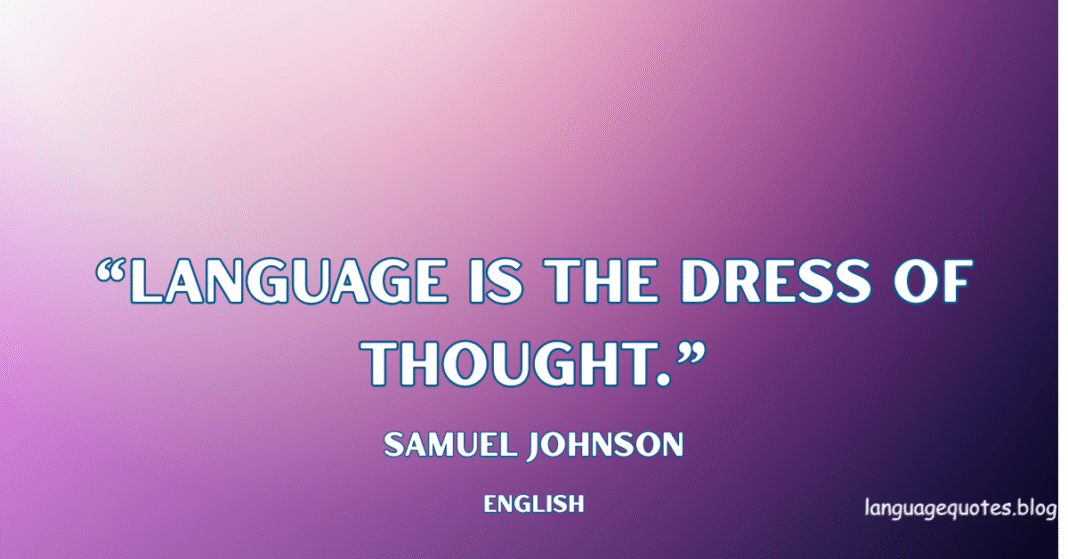“Language is the dress of thought.”
— Samuel Johnson
🗨️ Two-Line Commentary:
A brilliant thought, if expressed poorly, loses its shine. This quote urges us to treat language not just as a utility, but as an elegant necessity for bringing thoughts to life.
🧵 Introduction: Thought, Elegantly Dressed
Samuel Johnson, the towering figure of 18th-century English letters, once observed that “Language is the dress of thought.” This deceptively simple quote holds profound significance—not only for writers, thinkers, and speakers, but for anyone seeking to understand the vital role of language in human expression.
Johnson, best known for compiling one of the first comprehensive English dictionaries, was a champion of clarity, order, and eloquence in communication. With this quote, he encapsulates the idea that just as clothing shapes how we are perceived, language shapes how our thoughts are received. Thoughts, no matter how brilliant, remain inaccessible unless properly “dressed” in words.
🧠 Language as Expression: Shaping Inner Worlds
Our thoughts originate in silence—in the private recesses of the mind. They are abstract, unstructured, sometimes chaotic. It is through language that these thoughts acquire form. Without language, our ideas would remain locked within, inaccessible to others and even vague to ourselves.
When Johnson calls language a “dress”, he isn’t trivializing it; he’s emphasizing its importance. Just as a well-tailored outfit enhances appearance, a well-constructed sentence enhances comprehension. The metaphor suggests intentionality: we choose our words to best reflect the nature of our thoughts, much like we choose clothes to suit an occasion or identity.
✍️ The Writer’s Dilemma: Language as Craft
For writers and poets, this quote hits home. Crafting a message isn’t simply about typing words—it’s about aligning those words precisely with the emotion or idea they’re meant to convey. Poorly chosen words can distort meaning, much like ill-fitting clothes can misrepresent character.
This is why authors revise endlessly. They know that the first draft of a thought may lack clarity or grace, and through the revision of language, the thought becomes visible, elegant, and shareable. Whether you’re writing a sonnet, an article, or a tweet, you’re dressing up your thought for the world to see.
🗣️ Public Speaking and Communication: First Impressions
In public speaking, language is equally vital. A clear, thoughtful message garners respect and attention. The way we “dress” our ideas—through tone, vocabulary, structure—can determine whether we inspire or confuse our listeners.
Consider world leaders, teachers, or activists. Their ability to sway minds often comes down to how they articulate their ideas. Emotional appeals, logical structures, vivid metaphors—all are linguistic garments tailored to fit the message.
🌐 Language and Culture: Dress Across Borders
The beauty of language lies not only in expression but also in identity. Just as clothing can signal cultural affiliation, so can dialects, idioms, and mother tongues. Language is both a personal and communal expression.
A speaker of Urdu, French, or Japanese “dresses” their thoughts differently than one speaking English—not just in vocabulary, but in worldview, cadence, and cultural nuance. This reinforces Johnson’s point: language shapes not only how we communicate, but also how we think and experience life.
In translation, we often struggle to capture the full essence of a phrase because the “dress” of one language doesn’t always fit another. This proves language is not a mere tool—it’s an extension of thought itself.
🧩 Cognitive Science: Language Shapes Thinking
Modern linguists and psychologists echo Johnson’s sentiment. The Sapir-Whorf Hypothesis suggests that the structure of a language affects its speaker’s cognition and worldview. In other words, the limits of our language may also be the limits of our thoughts.
For example, languages that don’t use tenses may lead their speakers to perceive time differently. Cultures with multiple words for “snow” or “love” may experience those concepts more richly. Johnson, well ahead of his time, understood that language doesn’t just reflect thought—it molds it.
🖋️ About the Author: Who Was Samuel Johnson?
Samuel Johnson (1709–1784) was an English writer, lexicographer, critic, and moralist. He is best remembered for compiling A Dictionary of the English Language in 1755, a monumental work that shaped English lexicography for generations.
Johnson’s understanding of the interplay between words and meaning was unmatched in his time. He saw language as a medium of both clarity and culture. His essays, biographies, and aphorisms continue to inspire modern communicators and scholars.
This quote, while short, embodies his lifelong belief in the power, elegance, and necessity of precision in language.
🕊️ Modern Application: In the Age of Information
In today’s fast-paced digital era, Johnson’s quote becomes even more urgent. Every day, we dress our thoughts in text messages, blog posts, tweets, and emails. Yet, the speed of communication often leads us to choose convenience over clarity.
As artificial intelligence begins to mimic language, the human responsibility to express authentic and meaningful thought becomes more important than ever. Dressing thoughts with care isn’t old-fashioned—it’s revolutionary.
In a world full of noise, clarity becomes a virtue.
🎓 Final Thoughts: Thought Deserves Its Finest Dress
Samuel Johnson’s quote reminds us that our thoughts, no matter how noble or original, require a proper vehicle to be understood. That vehicle is language, and when used with intention, it becomes a tool for beauty, connection, persuasion, and truth.
So, whether you’re speaking your mind, writing a novel, or crafting a social media post, consider this: your thoughts deserve to be dressed with dignity and precision. For in language, we shape the world’s perception of what lives inside us.









